Analysis of Williams v Roffey Bros on the Doctrine of Consideration
VerifiedAdded on 2020/02/05
|10
|2513
|122
Essay
AI Summary
This essay delves into the doctrine of consideration within English common law, a fundamental element for establishing legally binding contracts, alongside offer and acceptance. It examines the impact of Williams v Roffey Bros & Nicholls (1989) on this doctrine, which has been the subject of much debate. The essay defines consideration, its role in distinguishing social agreements from legally enforceable contracts, and how it evolved through court decisions. It analyzes the specifics of the Williams v Roffey Bros case, where the court ruled that an agreement to pay additional money was enforceable. The essay discusses the concept of "practical benefit" and its implications, as well as the arguments for and against this ruling. It considers how the case relates to the principle of pre-existing contractual obligations, and the preservation of bargaining transactions. The conclusion emphasizes that equating practical benefit to consideration alters the meaning of acceptance, and the overall impact on contractual liability.

THE DOCTRINE OF CONSIDERATION 1
The Doctrine of Consideration: Williams V Roffey Bros & Nicholls
Name
Course
Tutor
Module
Institution
The Doctrine of Consideration: Williams V Roffey Bros & Nicholls
Name
Course
Tutor
Module
Institution
Paraphrase This Document
Need a fresh take? Get an instant paraphrase of this document with our AI Paraphraser
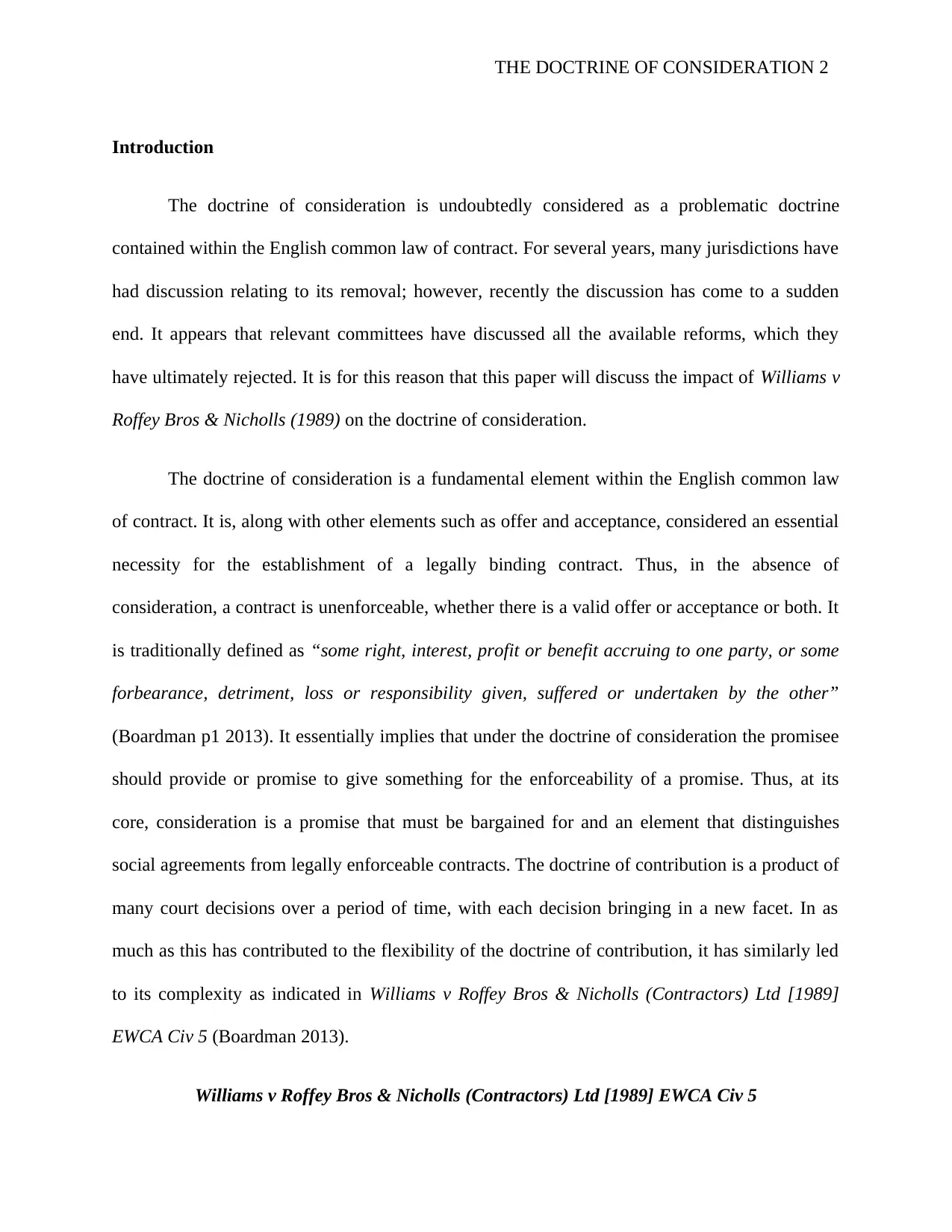
THE DOCTRINE OF CONSIDERATION 2
Introduction
The doctrine of consideration is undoubtedly considered as a problematic doctrine
contained within the English common law of contract. For several years, many jurisdictions have
had discussion relating to its removal; however, recently the discussion has come to a sudden
end. It appears that relevant committees have discussed all the available reforms, which they
have ultimately rejected. It is for this reason that this paper will discuss the impact of Williams v
Roffey Bros & Nicholls (1989) on the doctrine of consideration.
The doctrine of consideration is a fundamental element within the English common law
of contract. It is, along with other elements such as offer and acceptance, considered an essential
necessity for the establishment of a legally binding contract. Thus, in the absence of
consideration, a contract is unenforceable, whether there is a valid offer or acceptance or both. It
is traditionally defined as “some right, interest, profit or benefit accruing to one party, or some
forbearance, detriment, loss or responsibility given, suffered or undertaken by the other”
(Boardman p1 2013). It essentially implies that under the doctrine of consideration the promisee
should provide or promise to give something for the enforceability of a promise. Thus, at its
core, consideration is a promise that must be bargained for and an element that distinguishes
social agreements from legally enforceable contracts. The doctrine of contribution is a product of
many court decisions over a period of time, with each decision bringing in a new facet. In as
much as this has contributed to the flexibility of the doctrine of contribution, it has similarly led
to its complexity as indicated in Williams v Roffey Bros & Nicholls (Contractors) Ltd [1989]
EWCA Civ 5 (Boardman 2013).
Williams v Roffey Bros & Nicholls (Contractors) Ltd [1989] EWCA Civ 5
Introduction
The doctrine of consideration is undoubtedly considered as a problematic doctrine
contained within the English common law of contract. For several years, many jurisdictions have
had discussion relating to its removal; however, recently the discussion has come to a sudden
end. It appears that relevant committees have discussed all the available reforms, which they
have ultimately rejected. It is for this reason that this paper will discuss the impact of Williams v
Roffey Bros & Nicholls (1989) on the doctrine of consideration.
The doctrine of consideration is a fundamental element within the English common law
of contract. It is, along with other elements such as offer and acceptance, considered an essential
necessity for the establishment of a legally binding contract. Thus, in the absence of
consideration, a contract is unenforceable, whether there is a valid offer or acceptance or both. It
is traditionally defined as “some right, interest, profit or benefit accruing to one party, or some
forbearance, detriment, loss or responsibility given, suffered or undertaken by the other”
(Boardman p1 2013). It essentially implies that under the doctrine of consideration the promisee
should provide or promise to give something for the enforceability of a promise. Thus, at its
core, consideration is a promise that must be bargained for and an element that distinguishes
social agreements from legally enforceable contracts. The doctrine of contribution is a product of
many court decisions over a period of time, with each decision bringing in a new facet. In as
much as this has contributed to the flexibility of the doctrine of contribution, it has similarly led
to its complexity as indicated in Williams v Roffey Bros & Nicholls (Contractors) Ltd [1989]
EWCA Civ 5 (Boardman 2013).
Williams v Roffey Bros & Nicholls (Contractors) Ltd [1989] EWCA Civ 5
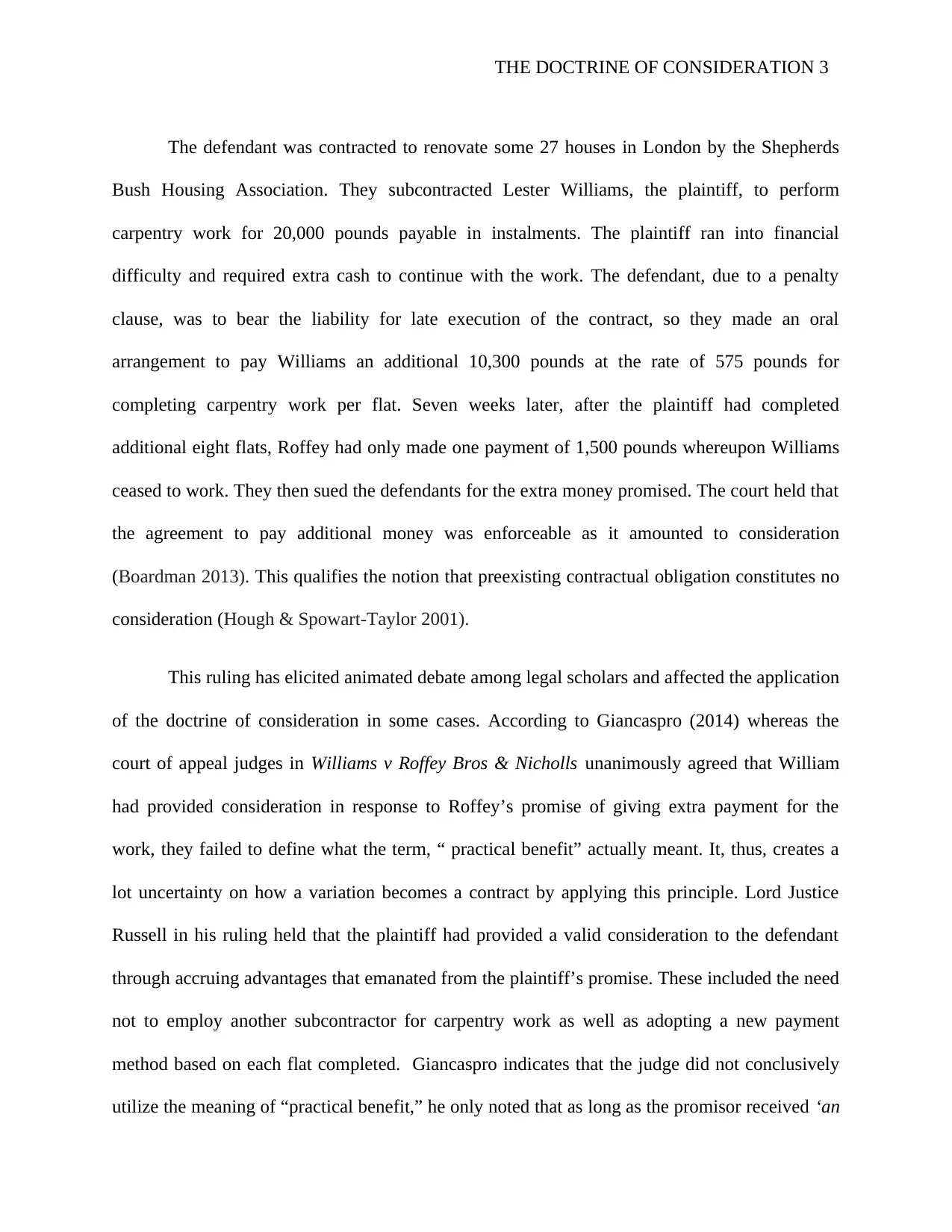
THE DOCTRINE OF CONSIDERATION 3
The defendant was contracted to renovate some 27 houses in London by the Shepherds
Bush Housing Association. They subcontracted Lester Williams, the plaintiff, to perform
carpentry work for 20,000 pounds payable in instalments. The plaintiff ran into financial
difficulty and required extra cash to continue with the work. The defendant, due to a penalty
clause, was to bear the liability for late execution of the contract, so they made an oral
arrangement to pay Williams an additional 10,300 pounds at the rate of 575 pounds for
completing carpentry work per flat. Seven weeks later, after the plaintiff had completed
additional eight flats, Roffey had only made one payment of 1,500 pounds whereupon Williams
ceased to work. They then sued the defendants for the extra money promised. The court held that
the agreement to pay additional money was enforceable as it amounted to consideration
(Boardman 2013). This qualifies the notion that preexisting contractual obligation constitutes no
consideration (Hough & Spowart-Taylor 2001).
This ruling has elicited animated debate among legal scholars and affected the application
of the doctrine of consideration in some cases. According to Giancaspro (2014) whereas the
court of appeal judges in Williams v Roffey Bros & Nicholls unanimously agreed that William
had provided consideration in response to Roffey’s promise of giving extra payment for the
work, they failed to define what the term, “ practical benefit” actually meant. It, thus, creates a
lot uncertainty on how a variation becomes a contract by applying this principle. Lord Justice
Russell in his ruling held that the plaintiff had provided a valid consideration to the defendant
through accruing advantages that emanated from the plaintiff’s promise. These included the need
not to employ another subcontractor for carpentry work as well as adopting a new payment
method based on each flat completed. Giancaspro indicates that the judge did not conclusively
utilize the meaning of “practical benefit,” he only noted that as long as the promisor received ‘an
The defendant was contracted to renovate some 27 houses in London by the Shepherds
Bush Housing Association. They subcontracted Lester Williams, the plaintiff, to perform
carpentry work for 20,000 pounds payable in instalments. The plaintiff ran into financial
difficulty and required extra cash to continue with the work. The defendant, due to a penalty
clause, was to bear the liability for late execution of the contract, so they made an oral
arrangement to pay Williams an additional 10,300 pounds at the rate of 575 pounds for
completing carpentry work per flat. Seven weeks later, after the plaintiff had completed
additional eight flats, Roffey had only made one payment of 1,500 pounds whereupon Williams
ceased to work. They then sued the defendants for the extra money promised. The court held that
the agreement to pay additional money was enforceable as it amounted to consideration
(Boardman 2013). This qualifies the notion that preexisting contractual obligation constitutes no
consideration (Hough & Spowart-Taylor 2001).
This ruling has elicited animated debate among legal scholars and affected the application
of the doctrine of consideration in some cases. According to Giancaspro (2014) whereas the
court of appeal judges in Williams v Roffey Bros & Nicholls unanimously agreed that William
had provided consideration in response to Roffey’s promise of giving extra payment for the
work, they failed to define what the term, “ practical benefit” actually meant. It, thus, creates a
lot uncertainty on how a variation becomes a contract by applying this principle. Lord Justice
Russell in his ruling held that the plaintiff had provided a valid consideration to the defendant
through accruing advantages that emanated from the plaintiff’s promise. These included the need
not to employ another subcontractor for carpentry work as well as adopting a new payment
method based on each flat completed. Giancaspro indicates that the judge did not conclusively
utilize the meaning of “practical benefit,” he only noted that as long as the promisor received ‘an
⊘ This is a preview!⊘
Do you want full access?
Subscribe today to unlock all pages.

Trusted by 1+ million students worldwide
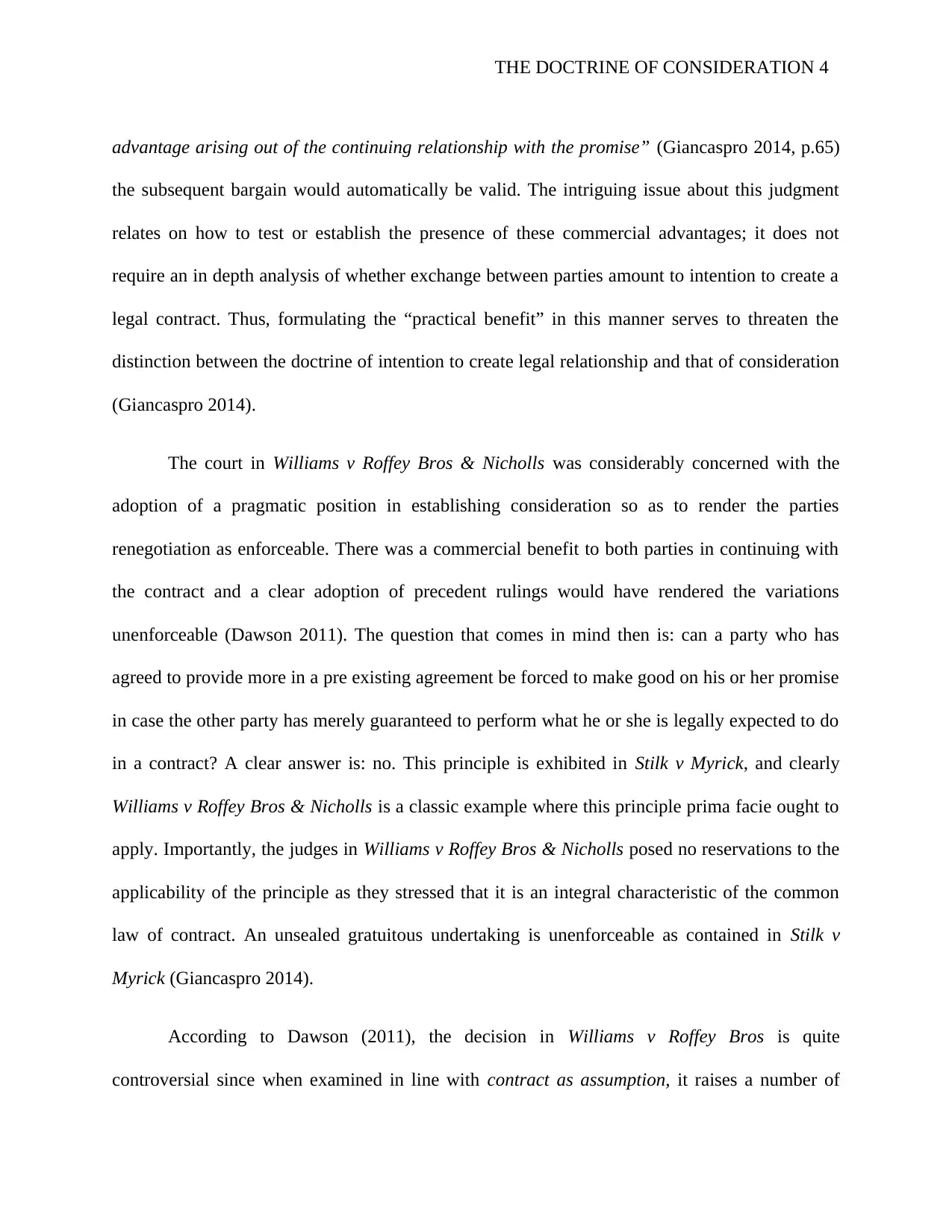
THE DOCTRINE OF CONSIDERATION 4
advantage arising out of the continuing relationship with the promise” (Giancaspro 2014, p.65)
the subsequent bargain would automatically be valid. The intriguing issue about this judgment
relates on how to test or establish the presence of these commercial advantages; it does not
require an in depth analysis of whether exchange between parties amount to intention to create a
legal contract. Thus, formulating the “practical benefit” in this manner serves to threaten the
distinction between the doctrine of intention to create legal relationship and that of consideration
(Giancaspro 2014).
The court in Williams v Roffey Bros & Nicholls was considerably concerned with the
adoption of a pragmatic position in establishing consideration so as to render the parties
renegotiation as enforceable. There was a commercial benefit to both parties in continuing with
the contract and a clear adoption of precedent rulings would have rendered the variations
unenforceable (Dawson 2011). The question that comes in mind then is: can a party who has
agreed to provide more in a pre existing agreement be forced to make good on his or her promise
in case the other party has merely guaranteed to perform what he or she is legally expected to do
in a contract? A clear answer is: no. This principle is exhibited in Stilk v Myrick, and clearly
Williams v Roffey Bros & Nicholls is a classic example where this principle prima facie ought to
apply. Importantly, the judges in Williams v Roffey Bros & Nicholls posed no reservations to the
applicability of the principle as they stressed that it is an integral characteristic of the common
law of contract. An unsealed gratuitous undertaking is unenforceable as contained in Stilk v
Myrick (Giancaspro 2014).
According to Dawson (2011), the decision in Williams v Roffey Bros is quite
controversial since when examined in line with contract as assumption, it raises a number of
advantage arising out of the continuing relationship with the promise” (Giancaspro 2014, p.65)
the subsequent bargain would automatically be valid. The intriguing issue about this judgment
relates on how to test or establish the presence of these commercial advantages; it does not
require an in depth analysis of whether exchange between parties amount to intention to create a
legal contract. Thus, formulating the “practical benefit” in this manner serves to threaten the
distinction between the doctrine of intention to create legal relationship and that of consideration
(Giancaspro 2014).
The court in Williams v Roffey Bros & Nicholls was considerably concerned with the
adoption of a pragmatic position in establishing consideration so as to render the parties
renegotiation as enforceable. There was a commercial benefit to both parties in continuing with
the contract and a clear adoption of precedent rulings would have rendered the variations
unenforceable (Dawson 2011). The question that comes in mind then is: can a party who has
agreed to provide more in a pre existing agreement be forced to make good on his or her promise
in case the other party has merely guaranteed to perform what he or she is legally expected to do
in a contract? A clear answer is: no. This principle is exhibited in Stilk v Myrick, and clearly
Williams v Roffey Bros & Nicholls is a classic example where this principle prima facie ought to
apply. Importantly, the judges in Williams v Roffey Bros & Nicholls posed no reservations to the
applicability of the principle as they stressed that it is an integral characteristic of the common
law of contract. An unsealed gratuitous undertaking is unenforceable as contained in Stilk v
Myrick (Giancaspro 2014).
According to Dawson (2011), the decision in Williams v Roffey Bros is quite
controversial since when examined in line with contract as assumption, it raises a number of
Paraphrase This Document
Need a fresh take? Get an instant paraphrase of this document with our AI Paraphraser
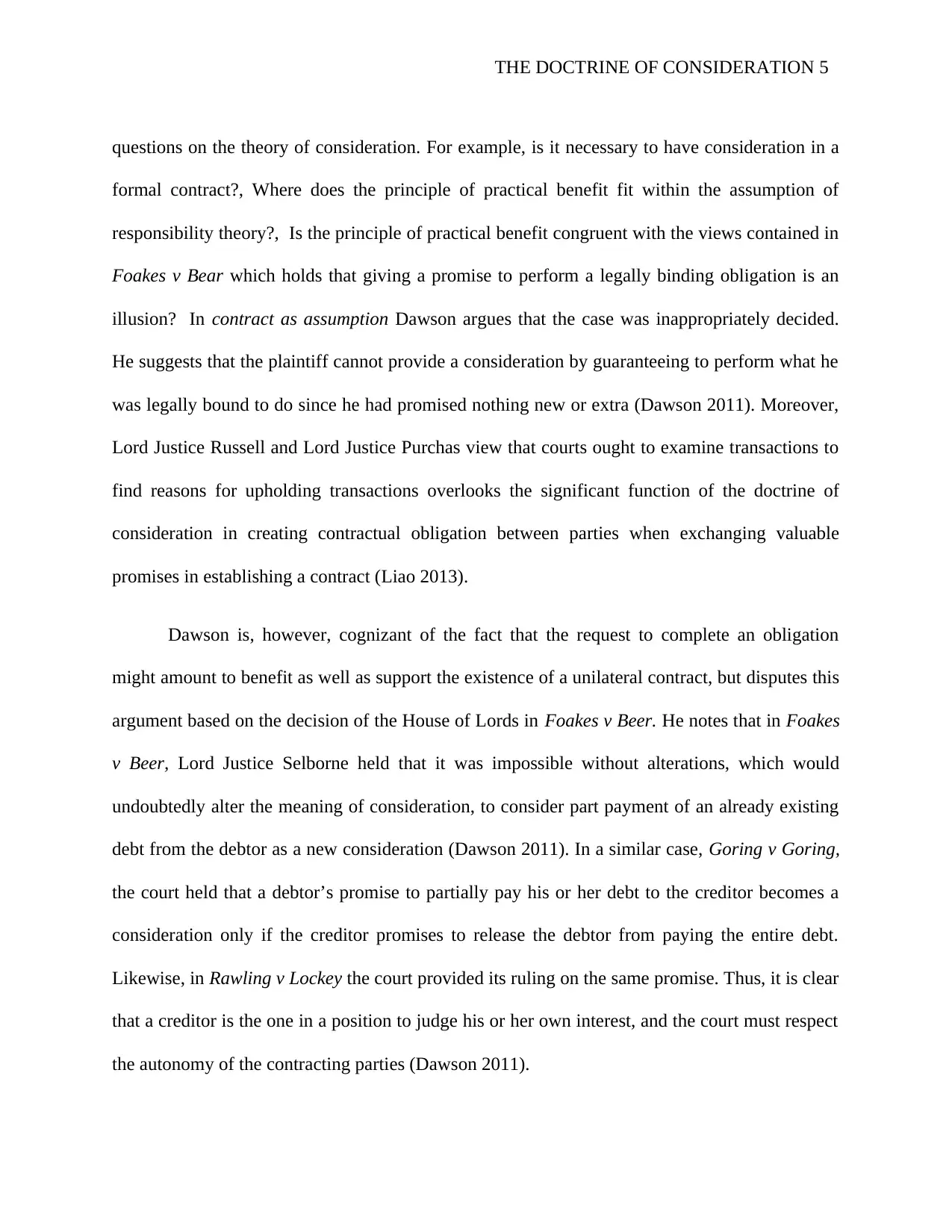
THE DOCTRINE OF CONSIDERATION 5
questions on the theory of consideration. For example, is it necessary to have consideration in a
formal contract?, Where does the principle of practical benefit fit within the assumption of
responsibility theory?, Is the principle of practical benefit congruent with the views contained in
Foakes v Bear which holds that giving a promise to perform a legally binding obligation is an
illusion? In contract as assumption Dawson argues that the case was inappropriately decided.
He suggests that the plaintiff cannot provide a consideration by guaranteeing to perform what he
was legally bound to do since he had promised nothing new or extra (Dawson 2011). Moreover,
Lord Justice Russell and Lord Justice Purchas view that courts ought to examine transactions to
find reasons for upholding transactions overlooks the significant function of the doctrine of
consideration in creating contractual obligation between parties when exchanging valuable
promises in establishing a contract (Liao 2013).
Dawson is, however, cognizant of the fact that the request to complete an obligation
might amount to benefit as well as support the existence of a unilateral contract, but disputes this
argument based on the decision of the House of Lords in Foakes v Beer. He notes that in Foakes
v Beer, Lord Justice Selborne held that it was impossible without alterations, which would
undoubtedly alter the meaning of consideration, to consider part payment of an already existing
debt from the debtor as a new consideration (Dawson 2011). In a similar case, Goring v Goring,
the court held that a debtor’s promise to partially pay his or her debt to the creditor becomes a
consideration only if the creditor promises to release the debtor from paying the entire debt.
Likewise, in Rawling v Lockey the court provided its ruling on the same promise. Thus, it is clear
that a creditor is the one in a position to judge his or her own interest, and the court must respect
the autonomy of the contracting parties (Dawson 2011).
questions on the theory of consideration. For example, is it necessary to have consideration in a
formal contract?, Where does the principle of practical benefit fit within the assumption of
responsibility theory?, Is the principle of practical benefit congruent with the views contained in
Foakes v Bear which holds that giving a promise to perform a legally binding obligation is an
illusion? In contract as assumption Dawson argues that the case was inappropriately decided.
He suggests that the plaintiff cannot provide a consideration by guaranteeing to perform what he
was legally bound to do since he had promised nothing new or extra (Dawson 2011). Moreover,
Lord Justice Russell and Lord Justice Purchas view that courts ought to examine transactions to
find reasons for upholding transactions overlooks the significant function of the doctrine of
consideration in creating contractual obligation between parties when exchanging valuable
promises in establishing a contract (Liao 2013).
Dawson is, however, cognizant of the fact that the request to complete an obligation
might amount to benefit as well as support the existence of a unilateral contract, but disputes this
argument based on the decision of the House of Lords in Foakes v Beer. He notes that in Foakes
v Beer, Lord Justice Selborne held that it was impossible without alterations, which would
undoubtedly alter the meaning of consideration, to consider part payment of an already existing
debt from the debtor as a new consideration (Dawson 2011). In a similar case, Goring v Goring,
the court held that a debtor’s promise to partially pay his or her debt to the creditor becomes a
consideration only if the creditor promises to release the debtor from paying the entire debt.
Likewise, in Rawling v Lockey the court provided its ruling on the same promise. Thus, it is clear
that a creditor is the one in a position to judge his or her own interest, and the court must respect
the autonomy of the contracting parties (Dawson 2011).
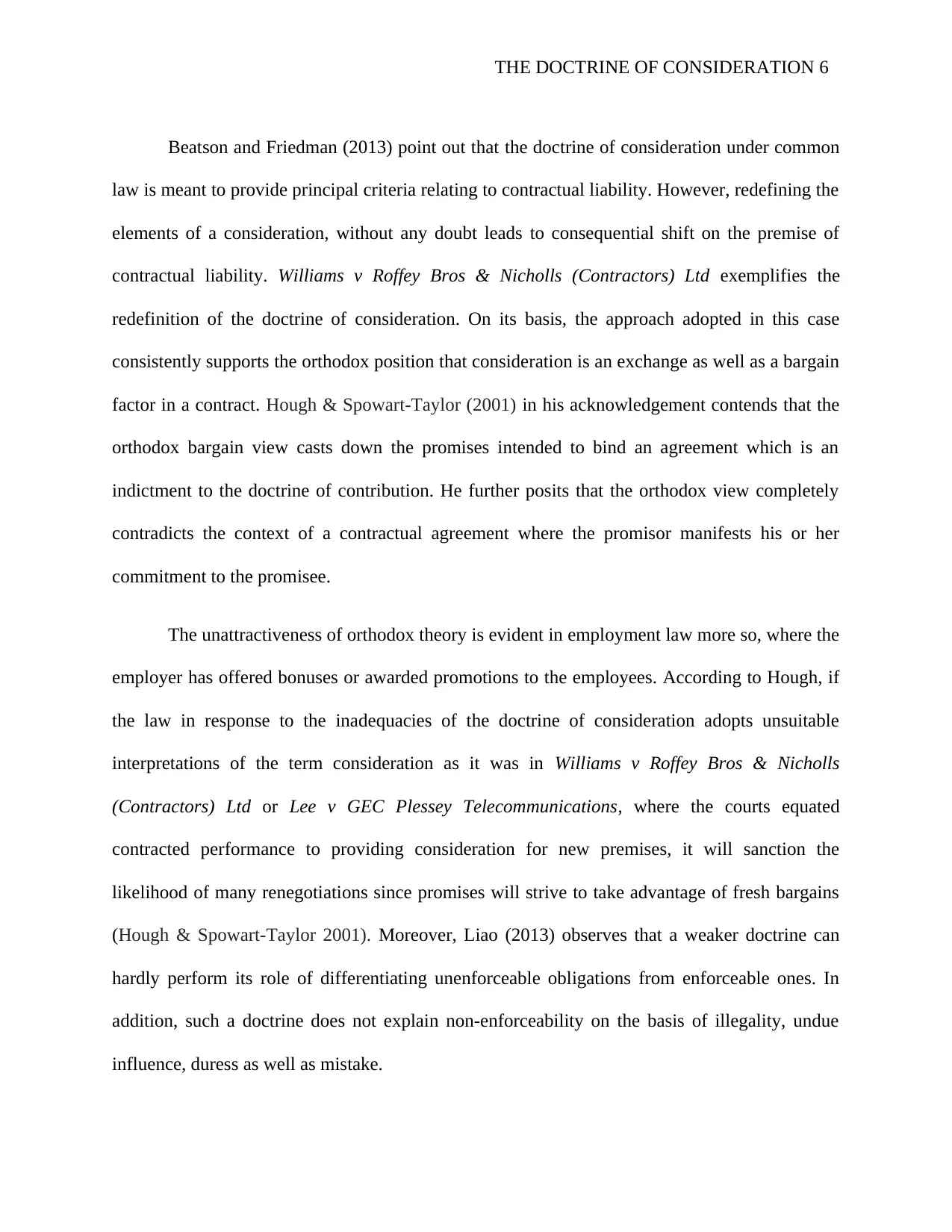
THE DOCTRINE OF CONSIDERATION 6
Beatson and Friedman (2013) point out that the doctrine of consideration under common
law is meant to provide principal criteria relating to contractual liability. However, redefining the
elements of a consideration, without any doubt leads to consequential shift on the premise of
contractual liability. Williams v Roffey Bros & Nicholls (Contractors) Ltd exemplifies the
redefinition of the doctrine of consideration. On its basis, the approach adopted in this case
consistently supports the orthodox position that consideration is an exchange as well as a bargain
factor in a contract. Hough & Spowart-Taylor (2001) in his acknowledgement contends that the
orthodox bargain view casts down the promises intended to bind an agreement which is an
indictment to the doctrine of contribution. He further posits that the orthodox view completely
contradicts the context of a contractual agreement where the promisor manifests his or her
commitment to the promisee.
The unattractiveness of orthodox theory is evident in employment law more so, where the
employer has offered bonuses or awarded promotions to the employees. According to Hough, if
the law in response to the inadequacies of the doctrine of consideration adopts unsuitable
interpretations of the term consideration as it was in Williams v Roffey Bros & Nicholls
(Contractors) Ltd or Lee v GEC Plessey Telecommunications, where the courts equated
contracted performance to providing consideration for new premises, it will sanction the
likelihood of many renegotiations since promises will strive to take advantage of fresh bargains
(Hough & Spowart-Taylor 2001). Moreover, Liao (2013) observes that a weaker doctrine can
hardly perform its role of differentiating unenforceable obligations from enforceable ones. In
addition, such a doctrine does not explain non-enforceability on the basis of illegality, undue
influence, duress as well as mistake.
Beatson and Friedman (2013) point out that the doctrine of consideration under common
law is meant to provide principal criteria relating to contractual liability. However, redefining the
elements of a consideration, without any doubt leads to consequential shift on the premise of
contractual liability. Williams v Roffey Bros & Nicholls (Contractors) Ltd exemplifies the
redefinition of the doctrine of consideration. On its basis, the approach adopted in this case
consistently supports the orthodox position that consideration is an exchange as well as a bargain
factor in a contract. Hough & Spowart-Taylor (2001) in his acknowledgement contends that the
orthodox bargain view casts down the promises intended to bind an agreement which is an
indictment to the doctrine of contribution. He further posits that the orthodox view completely
contradicts the context of a contractual agreement where the promisor manifests his or her
commitment to the promisee.
The unattractiveness of orthodox theory is evident in employment law more so, where the
employer has offered bonuses or awarded promotions to the employees. According to Hough, if
the law in response to the inadequacies of the doctrine of consideration adopts unsuitable
interpretations of the term consideration as it was in Williams v Roffey Bros & Nicholls
(Contractors) Ltd or Lee v GEC Plessey Telecommunications, where the courts equated
contracted performance to providing consideration for new premises, it will sanction the
likelihood of many renegotiations since promises will strive to take advantage of fresh bargains
(Hough & Spowart-Taylor 2001). Moreover, Liao (2013) observes that a weaker doctrine can
hardly perform its role of differentiating unenforceable obligations from enforceable ones. In
addition, such a doctrine does not explain non-enforceability on the basis of illegality, undue
influence, duress as well as mistake.
⊘ This is a preview!⊘
Do you want full access?
Subscribe today to unlock all pages.

Trusted by 1+ million students worldwide
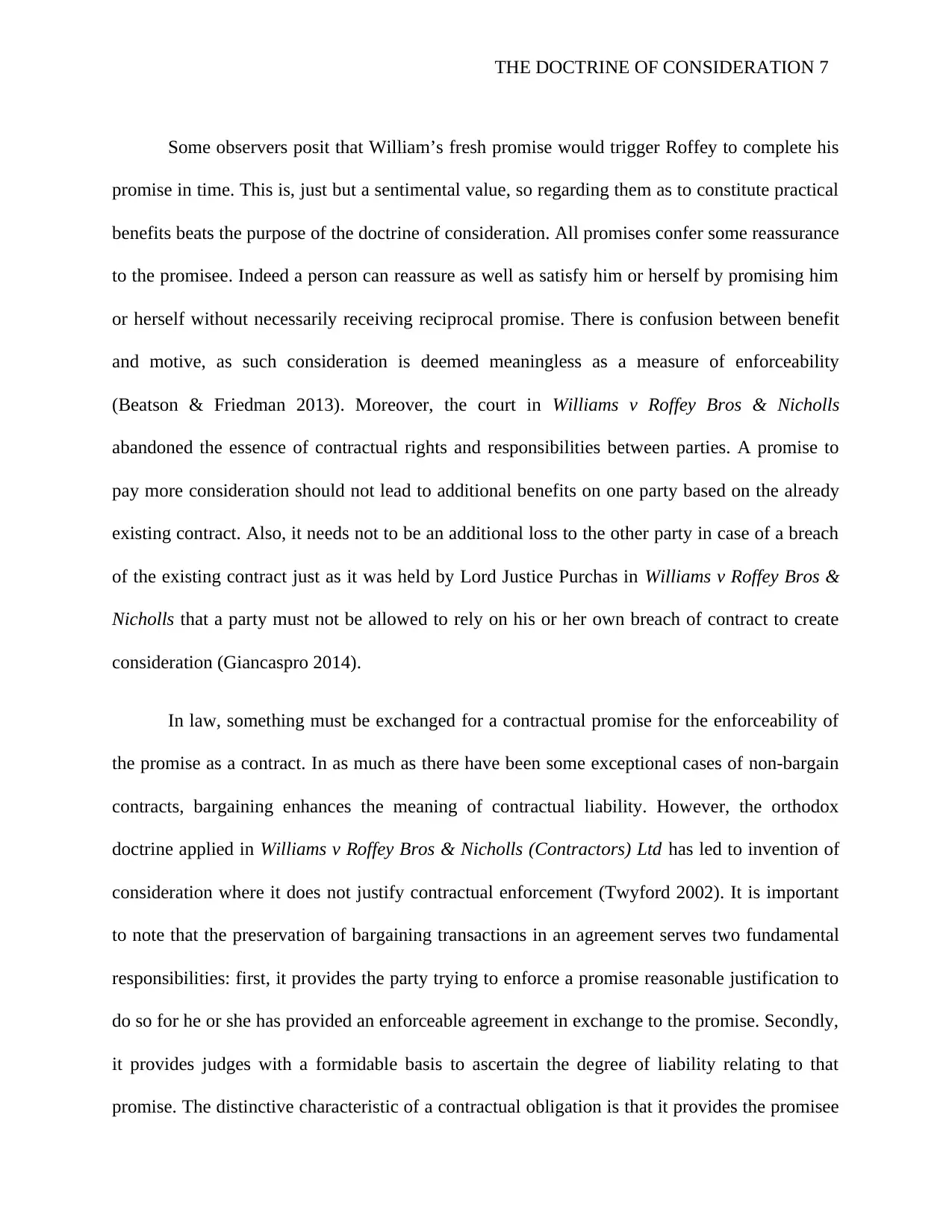
THE DOCTRINE OF CONSIDERATION 7
Some observers posit that William’s fresh promise would trigger Roffey to complete his
promise in time. This is, just but a sentimental value, so regarding them as to constitute practical
benefits beats the purpose of the doctrine of consideration. All promises confer some reassurance
to the promisee. Indeed a person can reassure as well as satisfy him or herself by promising him
or herself without necessarily receiving reciprocal promise. There is confusion between benefit
and motive, as such consideration is deemed meaningless as a measure of enforceability
(Beatson & Friedman 2013). Moreover, the court in Williams v Roffey Bros & Nicholls
abandoned the essence of contractual rights and responsibilities between parties. A promise to
pay more consideration should not lead to additional benefits on one party based on the already
existing contract. Also, it needs not to be an additional loss to the other party in case of a breach
of the existing contract just as it was held by Lord Justice Purchas in Williams v Roffey Bros &
Nicholls that a party must not be allowed to rely on his or her own breach of contract to create
consideration (Giancaspro 2014).
In law, something must be exchanged for a contractual promise for the enforceability of
the promise as a contract. In as much as there have been some exceptional cases of non-bargain
contracts, bargaining enhances the meaning of contractual liability. However, the orthodox
doctrine applied in Williams v Roffey Bros & Nicholls (Contractors) Ltd has led to invention of
consideration where it does not justify contractual enforcement (Twyford 2002). It is important
to note that the preservation of bargaining transactions in an agreement serves two fundamental
responsibilities: first, it provides the party trying to enforce a promise reasonable justification to
do so for he or she has provided an enforceable agreement in exchange to the promise. Secondly,
it provides judges with a formidable basis to ascertain the degree of liability relating to that
promise. The distinctive characteristic of a contractual obligation is that it provides the promisee
Some observers posit that William’s fresh promise would trigger Roffey to complete his
promise in time. This is, just but a sentimental value, so regarding them as to constitute practical
benefits beats the purpose of the doctrine of consideration. All promises confer some reassurance
to the promisee. Indeed a person can reassure as well as satisfy him or herself by promising him
or herself without necessarily receiving reciprocal promise. There is confusion between benefit
and motive, as such consideration is deemed meaningless as a measure of enforceability
(Beatson & Friedman 2013). Moreover, the court in Williams v Roffey Bros & Nicholls
abandoned the essence of contractual rights and responsibilities between parties. A promise to
pay more consideration should not lead to additional benefits on one party based on the already
existing contract. Also, it needs not to be an additional loss to the other party in case of a breach
of the existing contract just as it was held by Lord Justice Purchas in Williams v Roffey Bros &
Nicholls that a party must not be allowed to rely on his or her own breach of contract to create
consideration (Giancaspro 2014).
In law, something must be exchanged for a contractual promise for the enforceability of
the promise as a contract. In as much as there have been some exceptional cases of non-bargain
contracts, bargaining enhances the meaning of contractual liability. However, the orthodox
doctrine applied in Williams v Roffey Bros & Nicholls (Contractors) Ltd has led to invention of
consideration where it does not justify contractual enforcement (Twyford 2002). It is important
to note that the preservation of bargaining transactions in an agreement serves two fundamental
responsibilities: first, it provides the party trying to enforce a promise reasonable justification to
do so for he or she has provided an enforceable agreement in exchange to the promise. Secondly,
it provides judges with a formidable basis to ascertain the degree of liability relating to that
promise. The distinctive characteristic of a contractual obligation is that it provides the promisee
Paraphrase This Document
Need a fresh take? Get an instant paraphrase of this document with our AI Paraphraser

THE DOCTRINE OF CONSIDERATION 8
some value for having performed his or her promise since he or she has paid a consideration for
the agreement (Beatson & Friedman 2013).
Conclusion
Equating practical benefit to consideration essentially alters the meaning of acceptance
with far reaching distortions and dilution of the term contractual liability. This adoption of this
adjusted position is surely an extension; however, its applicability raises a lot of suspicion. Those
questioning the contractual effect of practical benefits do not deny the fact that particular
enforcements relating to promises are somehow desirable for other reasons rather than bargain.
The question should, therefore, be centered on whether the reasons for enforceability can be
addressed through a redefined view on bargaining or through a broader meaning of the term
consideration.
some value for having performed his or her promise since he or she has paid a consideration for
the agreement (Beatson & Friedman 2013).
Conclusion
Equating practical benefit to consideration essentially alters the meaning of acceptance
with far reaching distortions and dilution of the term contractual liability. This adoption of this
adjusted position is surely an extension; however, its applicability raises a lot of suspicion. Those
questioning the contractual effect of practical benefits do not deny the fact that particular
enforcements relating to promises are somehow desirable for other reasons rather than bargain.
The question should, therefore, be centered on whether the reasons for enforceability can be
addressed through a redefined view on bargaining or through a broader meaning of the term
consideration.
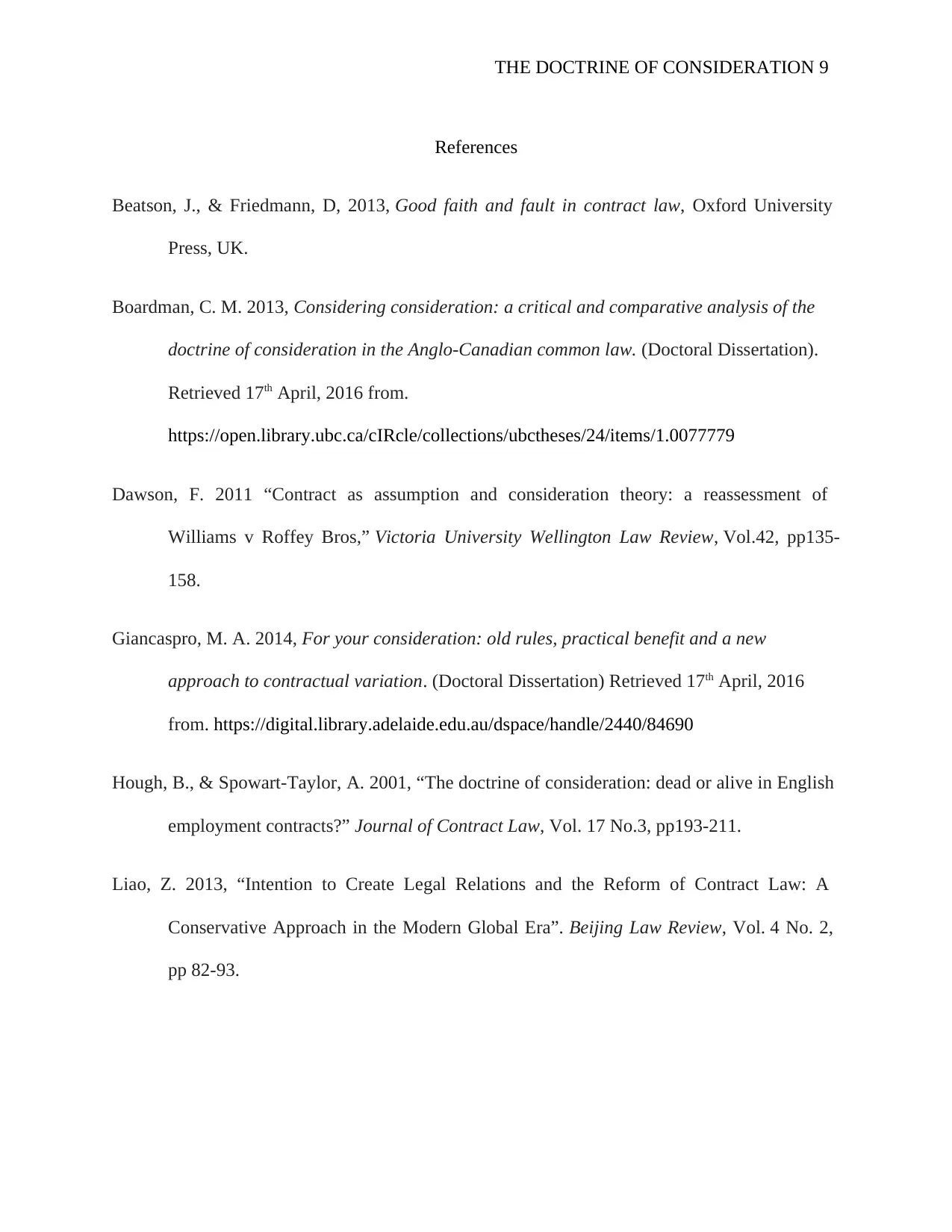
THE DOCTRINE OF CONSIDERATION 9
References
Beatson, J., & Friedmann, D, 2013, Good faith and fault in contract law, Oxford University
Press, UK.
Boardman, C. M. 2013, Considering consideration: a critical and comparative analysis of the
doctrine of consideration in the Anglo-Canadian common law. (Doctoral Dissertation).
Retrieved 17th April, 2016 from.
https://open.library.ubc.ca/cIRcle/collections/ubctheses/24/items/1.0077779
Dawson, F. 2011 “Contract as assumption and consideration theory: a reassessment of
Williams v Roffey Bros,” Victoria University Wellington Law Review, Vol.42, pp135-
158.
Giancaspro, M. A. 2014, For your consideration: old rules, practical benefit and a new
approach to contractual variation. (Doctoral Dissertation) Retrieved 17th April, 2016
from. https://digital.library.adelaide.edu.au/dspace/handle/2440/84690
Hough, B., & Spowart-Taylor, A. 2001, “The doctrine of consideration: dead or alive in English
employment contracts?” Journal of Contract Law, Vol. 17 No.3, pp193-211.
Liao, Z. 2013, “Intention to Create Legal Relations and the Reform of Contract Law: A
Conservative Approach in the Modern Global Era”. Beijing Law Review, Vol. 4 No. 2,
pp 82-93.
References
Beatson, J., & Friedmann, D, 2013, Good faith and fault in contract law, Oxford University
Press, UK.
Boardman, C. M. 2013, Considering consideration: a critical and comparative analysis of the
doctrine of consideration in the Anglo-Canadian common law. (Doctoral Dissertation).
Retrieved 17th April, 2016 from.
https://open.library.ubc.ca/cIRcle/collections/ubctheses/24/items/1.0077779
Dawson, F. 2011 “Contract as assumption and consideration theory: a reassessment of
Williams v Roffey Bros,” Victoria University Wellington Law Review, Vol.42, pp135-
158.
Giancaspro, M. A. 2014, For your consideration: old rules, practical benefit and a new
approach to contractual variation. (Doctoral Dissertation) Retrieved 17th April, 2016
from. https://digital.library.adelaide.edu.au/dspace/handle/2440/84690
Hough, B., & Spowart-Taylor, A. 2001, “The doctrine of consideration: dead or alive in English
employment contracts?” Journal of Contract Law, Vol. 17 No.3, pp193-211.
Liao, Z. 2013, “Intention to Create Legal Relations and the Reform of Contract Law: A
Conservative Approach in the Modern Global Era”. Beijing Law Review, Vol. 4 No. 2,
pp 82-93.
⊘ This is a preview!⊘
Do you want full access?
Subscribe today to unlock all pages.

Trusted by 1+ million students worldwide

THE DOCTRINE OF CONSIDERATION 10
Twyford, J. W. 2002, The doctrine of consideration:(the role of consideration in contract
modifications) (Doctoral dissertation). Retrieved 17th April, 2016 from.
https://opus.lib.uts.edu.au/bitstream/10453/20049/2/02Wholethesis.pdf
Twyford, J. W. 2002, The doctrine of consideration:(the role of consideration in contract
modifications) (Doctoral dissertation). Retrieved 17th April, 2016 from.
https://opus.lib.uts.edu.au/bitstream/10453/20049/2/02Wholethesis.pdf
1 out of 10
Related Documents
Your All-in-One AI-Powered Toolkit for Academic Success.
+13062052269
info@desklib.com
Available 24*7 on WhatsApp / Email
![[object Object]](/_next/static/media/star-bottom.7253800d.svg)
Unlock your academic potential
Copyright © 2020–2025 A2Z Services. All Rights Reserved. Developed and managed by ZUCOL.




